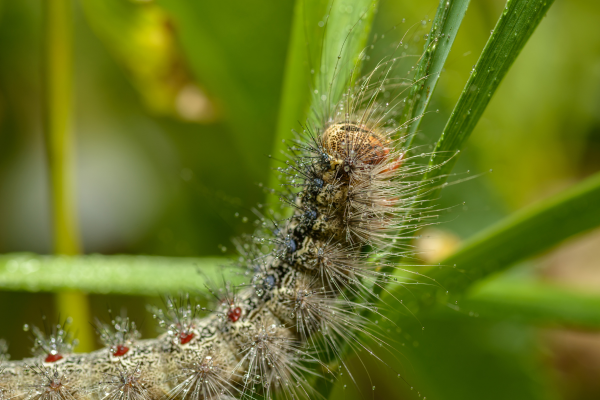Your cart is currently empty!

02 Jun What Conditions Do Spongy Moths Thrive In?
Once a symbol of exotic beauty, the spongy moth has become a notorious pest that wreaks havoc on trees and vegetation across North America. Originally brought over from Europe in the late 19th century, this moth’s insatiable appetite has caused significant damage to forests and landscapes, costing millions of dollars in control measures and lost revenue. But have you ever wondered what conditions allow these pests to thrive and spread their destruction? Understanding the environmental factors that contribute to the spongy moth’s success is key to preventing its spread and protecting our natural resources. So, let’s explore the conditions that these notorious pests thrive in and learn how we can stop them in their tracks.
1. Temperature
Spongy moths are native to Europe and Asia, but they were accidentally introduced to North America in the late 1800s. Since then, they have spread rapidly across the continent, causing significant damage to forests and ecosystems. Spongy moth larvae feed on the leaves of deciduous trees, such as oaks, maples, and birches, which can weaken or kill the trees if the infestation is severe.
One of the most important factors that influence the spongy moth’s survival is temperature. Spongy moth eggs need to experience a cold winter before they can hatch in the spring. However, they cannot survive in temperatures below -20 degrees Celsius, making Southern Ontario ideal for their growth and development. The region experiences mild winters, with average temperatures rarely dropping below -10 degrees Celsius.
The temperature also plays a critical role in the spongy moth’s life cycle. After hatching, the larvae feed on leaves and moults several times before entering the pupal stage. The pupae then develop into adult moths, which mate and lay eggs for the next generation. The ideal temperature for the larvae to develop is between 20 and 25 degrees Celsius, and they need access to a food source to survive.
2. Moisture
Moisture is another crucial factor in the spongy moth’s survival. The larvae require a certain level of humidity to prevent their bodies from drying out. In Southern Ontario, the region’s humid continental climate provides enough moisture for spongy moth larvae to thrive, especially in the spring and summer months when rainfall is more frequent.
3. Host Trees
The abundance of suitable host trees is also essential for spongy moth populations to grow. Deciduous trees provide an ideal food source for the larvae, and they are prevalent throughout Southern Ontario. The moths prefer oak trees, but they will also feed on maples, birches, and other species if oak trees are scarce.
4. Natural Predators
Natural predators and parasites can also have an impact on spongy moth populations. Birds, such as blue jays and chickadees, are known to feed on spongy moth larvae, reducing their numbers. Parasitic wasps and flies can also lay their eggs on spongy moth larvae, causing them to die before they can mature into adults. However, these natural control measures are often not enough to prevent large-scale infestations.
Impact Of Spongy Moths
The impact of spongy moth infestations can be severe, both ecologically and economically. The loss of leaves can weaken trees, making them more susceptible to other pests and diseases. The damage to forests can also have ripple effects on wildlife, water quality, and the economy. In some areas, the cost of controlling spongy moth populations can run into millions of dollars.
To mitigate the impact of spongy moths, several control strategies have been developed, including the use of chemical pesticides, pheromone traps, and biological control agents. However, these strategies have limitations and can have negative effects on the environment and non-target species.
While there are various methods to control spongy moth populations, the most effective solution is prevention. By taking steps to minimize the conditions in which spongy moths thrive, in we can protect our trees and forests from damage and maintain a healthy ecosystem.
As stewards of the environment, it’s our responsibility to ensure that we take the necessary steps to prevent the spread of spongy moths. By being aware of the conditions that favour their growth, we can take proactive measures to reduce their populations and safeguard our natural resources. When faced with the threat of spongy moth caterpillars wreaking havoc on your beloved trees, The Environmental Factor has created a product to eliminate these harmful caterpillars. Allow us to introduce The V9 Tree Belt – the ultimate weapon in keeping these pests at bay.
The V9 Tree Belt is a humane and eco-friendly solution that can be easily utilized. Simply wrap the belt around the trunk of any tree that could potentially become a host for caterpillars. This creates a barrier that prevents the little pests from climbing up and devouring your trees’ foliage. With the V9 Tree Belt, you can take a proactive approach to protect your trees and safeguard your landscape from the detrimental effects of spongy moth infestations.
Do not let spongy moth caterpillars get the best of your trees. Instead, take action and invest in the V9 Tree Belt today. You will be taking a proactive stance in protecting your landscape while also promoting a healthier environment for generations to come.


